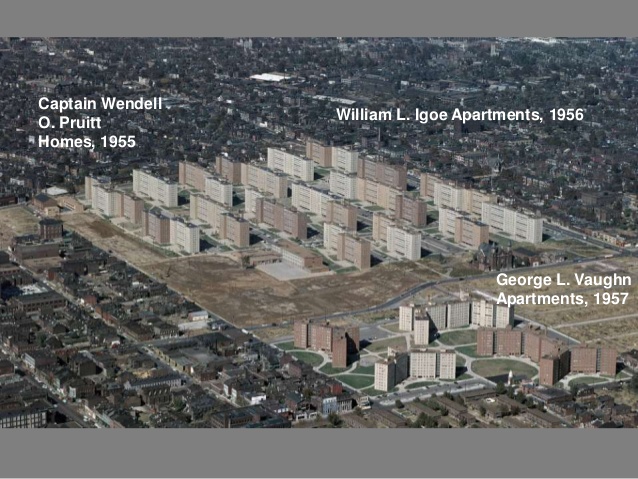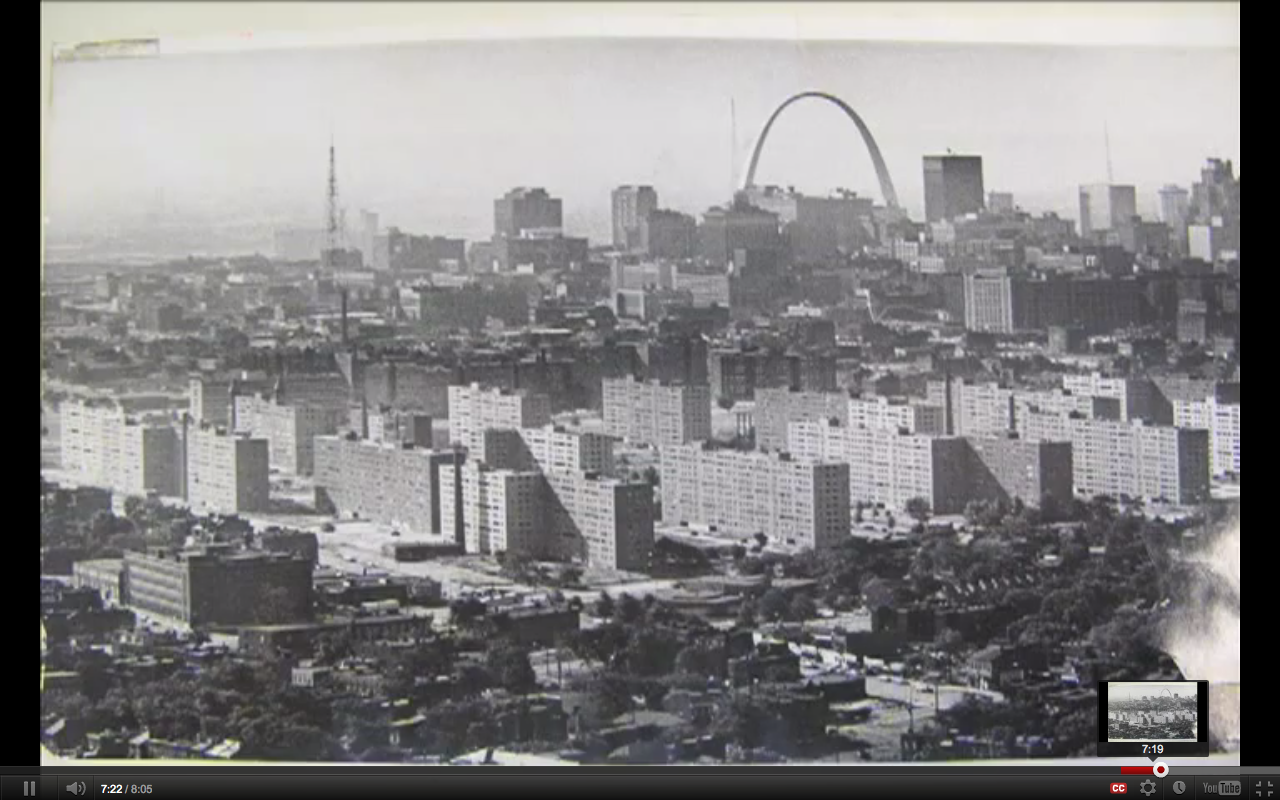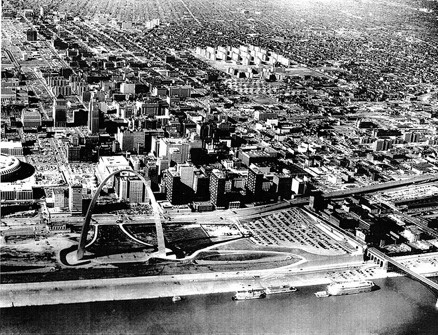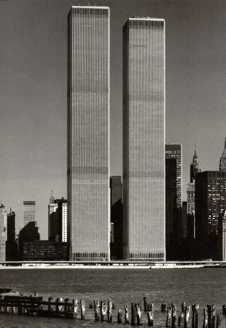It looks like you're using an Ad Blocker.
Please white-list or disable AboveTopSecret.com in your ad-blocking tool.
Thank you.
Some features of ATS will be disabled while you continue to use an ad-blocker.
Pruitt Igoe, Architectural Wonder, SegPublic Housing Failure, and Weaponised Radiation Experiment.
page: 17
share:
The Pruitt–Igoe housing project was one of the first demolitions of modernist architecture; postmodern architectural historian Charles Jencks called
its destruction "the day Modern architecture died."

quotes from wiki


The complex was designed by architect Minoru Yamasaki, who also designed the World Trade Center towers and the Lambert-St. Louis International Airportmain terminal.


By 1968 Pruitt-Igoe was a mess, you could see through to the other side of several of the buildings due to broken windows. The higher you went in the buildings the worse the crime would get.
In 1976 they decided to pull the buildings down, this was broadcast live on TV, and was filmed for the movie Koyaanisqatsi: Life Out of Balance, where it is the turning point of the movie, the movie is uplifting until this point, and then shows the evil of mankind after.
In 2011 two things happened,
One , a documentary called the Pruitt Igoe Myth was released to critical acclaim , film fest awards, and was a darling of the documentary circuit.
And Two, a story came out that only one local news station covered...
The second follow up story was even less known, yet way more disturbing and revealing, containing several witness testimonials.
www.cbsnews.com...
This was only covered on one local station and not picked up outside of St. Louis as far as I know.
from the dissertaion of Martino-Taylor, Lisa, Ph.D.,
A second part to this is on the way.

In 1950, the city commissioned the firm of Leinweber, Yamasaki & Hellmuth to design Pruitt–Igoe, a new complex named for St. Louisans Wendell O. Pruitt, an African-American fighter pilot inWorld War II, and William L. Igoe, a former U.S. Congressman. Originally, the city planned two partitions: Captain W. O. Pruitt Homes for the black residents, and William L. Igoe Apartments for whites.[11] The site was bound by Cass Avenue on the north, North Jefferson Avenue on the west, Carr Street on the south, and North 20th Street on the east.[6]
quotes from wiki

As completed in 1955, Pruitt–Igoe consisted of 33 11-story apartment buildingson a 57-acre (23 ha) site,[14] on St. Louis's lower north side. The complex totaled 2,870 apartments, one of the largest in the country.[10] The apartments were deliberately small, with undersized kitchen appliances.[10] "Skip-stop" elevators stopped only at the first, fourth, seventh, and tenth floors, forcing residents to use stairs in an attempt to lessen congestion. The same "anchor floors" were equipped with large communal corridors, laundry rooms, communal rooms andgarbage chutes.[13]

The complex was designed by architect Minoru Yamasaki, who also designed the World Trade Center towers and the Lambert-St. Louis International Airportmain terminal.


By 1968 Pruitt-Igoe was a mess, you could see through to the other side of several of the buildings due to broken windows. The higher you went in the buildings the worse the crime would get.
In 1976 they decided to pull the buildings down, this was broadcast live on TV, and was filmed for the movie Koyaanisqatsi: Life Out of Balance, where it is the turning point of the movie, the movie is uplifting until this point, and then shows the evil of mankind after.
In 2011 two things happened,
One , a documentary called the Pruitt Igoe Myth was released to critical acclaim , film fest awards, and was a darling of the documentary circuit.
And Two, a story came out that only one local news station covered...
The second follow up story was even less known, yet way more disturbing and revealing, containing several witness testimonials.
In the mid-1950s, and again a decade later, the Army used motorized blowers atop a low-income housing high-rise, at schools and from the backs of station wagons to send a potentially dangerous compound into the already-hazy air in predominantly black areas of St. Louis.
Local officials were told at the time that the government was testing a smoke screen that could shield St. Louis from aerial observation in case the Russians attacked.
But in 1994, the government said the tests were part of a biological weapons program and St. Louis was chosen because it bore some resemblance to Russian cities that the U.S. might attack. The material being sprayed was zinc cadmium sulfide, a fine fluorescent powder.
www.cbsnews.com...
This was only covered on one local station and not picked up outside of St. Louis as far as I know.
Abstract:
This piece analyzes a covert Manhattan Project spin-off organization referred to here as the Manhattan-Rochester Coalition, and an obscure aerosol study in St. Louis, Missouri, conducted under contract by the U.S. military from 1953–1954, and 1963–1965. The military-sponsored studies targeted a segregated, high-density urban area, where low-income persons of color predominantly resided. Examination of the Manhattan-Rochester Coalition and the St. Louis aerosol studies, reveal their connections to each other, and to a much larger military project that secretly tested humans, both alive and deceased, in an effort to understand the effects of weaponized radiation. Through this case study, the author explores how a large number of participants inside an organization will willingly participate in organizational acts that are harmful to others, and how large numbers of outsiders, who may or may not be victims of organizational activities, are unable to determine illegal or harmful activity by an organization. The author explains how ethical and observational lapses are engineered by the organization through several specific mechanisms, in an effort to disable critical analysis, and prevent both internal and external dissent of harmful organizational actions. Through studying the process of complex organizational deviance, we can develop public policies that protect the public's right to know, and construct checks and methods to minimize the chance of covert projects that are contrary to societal norms.
from the dissertaion of Martino-Taylor, Lisa, Ph.D.,
A second part to this is on the way.
So, in summary, in the 50's, various parts of the gubmint needed data on how airborne contamination spread. They used tracers which, at the time, were
thought to be innocuous, among them zcs and Serratia, because neither was considered a health hazard at the time and they're both very simple and
inexpensive to detect on surfaces, and they both give you a sort of quantitative measure of surface contamination as well.
About 60 years later, a humanities prof with no sciences background thinks "what if other things, for which I have no proof whatever, were done as well?" and "what if zcs, which we now know can be somewhat dangerous in large doses over long periods of time, is ALSO dangerous one time in a tiny dose?"
So basically, she's all horrified over something she thinks she thought might be true.
Got it.
Ok, prof. Here's the next bit of horror to be agog over - they do the same testing now, only with polymer powder. The testing instruments are a lot better. The agent is a lot more consistent. And you can get the same sorts of quantitative data, only you don't have to collect a lot of plates and swabs for examination in a lab. I suppose the polymer could be RADIOACTIVE (jarring chord) but that would serve no purpose, just as making the ZCS radioactive in 1955 would have been pointless for the purposes of THAT experiment.
About 60 years later, a humanities prof with no sciences background thinks "what if other things, for which I have no proof whatever, were done as well?" and "what if zcs, which we now know can be somewhat dangerous in large doses over long periods of time, is ALSO dangerous one time in a tiny dose?"
So basically, she's all horrified over something she thinks she thought might be true.
Got it.
Ok, prof. Here's the next bit of horror to be agog over - they do the same testing now, only with polymer powder. The testing instruments are a lot better. The agent is a lot more consistent. And you can get the same sorts of quantitative data, only you don't have to collect a lot of plates and swabs for examination in a lab. I suppose the polymer could be RADIOACTIVE (jarring chord) but that would serve no purpose, just as making the ZCS radioactive in 1955 would have been pointless for the purposes of THAT experiment.

Senator Roy Blunt

Senator Claire McCaskill
Both Senators said they were going to have their staff look into it, nothing was mentioned again until recenty.
The substance sprayed on the unsuspecting already desperate populace of Pruitt Igoe, would be used for tracking tracking them.
Something that might be useful to the National Geospatial-Intelligence Agency.
Well guess who Roy Blunt and Claire McCaskill got to move in to the vacant Pruitt Igoe site and build a 1.75 million dollar facility.
NGA Picks St. Louis for New $1.75 Billion West Headquarters
North St. Louis will be the home to the National Geospatial-Intelligence Agency’s new west headquarters—a decision heralded as a much-needed victory for a city better known for economic struggles, social and racial unrest, and the loss of its NFL team than for its decades-long relationship with the spy agency.
NGA Director Robert Cardillo called St. Louis Mayor Francis Slay Thursday with the news that St. Louis was his top pick for the new development. An NGA report names St. Louis is the “prefered” site for the new $1.75 billion facility on the 99-acre urban site at the intersection of N. Jefferson and Cass avenues, just north of the former Pruitt-Igoe housing development.
edit on 31-1-2017 by FreakySteve because: typo
originally posted by: FreakySteve
Senator Roy Blunt
Senator Claire McCaskill
Both Senators said they were going to have their staff look into it, nothing was mentioned again until recenty.
The substance sprayed on the unsuspecting already desperate populace of Pruitt Igoe, would be used for tracking tracking them.
Something that might be useful to the National Geospatial-Intelligence Agency.
Well guess who Roy Blunt and Claire McCaskill got to move in to the vacant Pruitt Igoe site and build a 1.75 million dollar facility.
NGA Picks St. Louis for New $1.75 Billion West Headquarters
North St. Louis will be the home to the National Geospatial-Intelligence Agency’s new west headquarters—a decision heralded as a much-needed victory for a city better known for economic struggles, social and racial unrest, and the loss of its NFL team than for its decades-long relationship with the spy agency.
NGA Director Robert Cardillo called St. Louis Mayor Francis Slay Thursday with the news that St. Louis was his top pick for the new development. An NGA report names St. Louis is the “prefered” site for the new $1.75 billion facility on the 99-acre urban site at the intersection of N. Jefferson and Cass avenues, just north of the former Pruitt-Igoe housing development.
Blunt, in his letter to the Army secretary, questioned whether radioactive testing was performed.
“The idea that thousands of Missourians were unwillingly exposed to harmful materials in order to determine their health effects is absolutely shocking,” the senator wrote.
McCaskill agreed. “Given the nature of these experiments, it’s not surprising that Missouri citizens still have questions and concerns about what exactly occurred and if there may have been any negative health effects,” she said in a statement.
originally posted by: Bedlam
So, in summary, in the 50's, various parts of the gubmint needed data on how airborne contamination spread. They used tracers which, at the time, were thought to be innocuous, among them zcs and Serratia, because neither was considered a health hazard at the time and they're both very simple and inexpensive to detect on surfaces, and they both give you a sort of quantitative measure of surface contamination as well.
About 60 years later, a humanities prof with no sciences background thinks "what if other things, for which I have no proof whatever, were done as well?" and "what if zcs, which we now know can be somewhat dangerous in large doses over long periods of time, is ALSO dangerous one time in a tiny dose?"
So basically, she's all horrified over something she thinks she thought might be true.
Got it.
Ok, prof. Here's the next bit of horror to be agog over - they do the same testing now, only with polymer powder. The testing instruments are a lot better. The agent is a lot more consistent. And you can get the same sorts of quantitative data, only you don't have to collect a lot of plates and swabs for examination in a lab. I suppose the polymer could be RADIOACTIVE (jarring chord) but that would serve no purpose, just as making the ZCS radioactive in 1955 would have been pointless for the purposes of THAT experiment.
The Army tested on people without their knowledge, and they used the poorest of the poor crammed into small cage apartments to do these experiments.
It would be pretty callous and naive to not see some ethical problems with that situation.
edit on 31-1-2017 by FreakySteve because: (no reason
given)
originally posted by: FreakySteve
originally posted by: Bedlam
So, in summary, in the 50's, various parts of the gubmint needed data on how airborne contamination spread. They used tracers which, at the time, were thought to be innocuous, among them zcs and Serratia, because neither was considered a health hazard at the time and they're both very simple and inexpensive to detect on surfaces, and they both give you a sort of quantitative measure of surface contamination as well.
About 60 years later, a humanities prof with no sciences background thinks "what if other things, for which I have no proof whatever, were done as well?" and "what if zcs, which we now know can be somewhat dangerous in large doses over long periods of time, is ALSO dangerous one time in a tiny dose?"
So basically, she's all horrified over something she thinks she thought might be true.
Got it.
Ok, prof. Here's the next bit of horror to be agog over - they do the same testing now, only with polymer powder. The testing instruments are a lot better. The agent is a lot more consistent. And you can get the same sorts of quantitative data, only you don't have to collect a lot of plates and swabs for examination in a lab. I suppose the polymer could be RADIOACTIVE (jarring chord) but that would serve no purpose, just as making the ZCS radioactive in 1955 would have been pointless for the purposes of THAT experiment.
The Army tested on people without their knowledge, and they used the poorest of the poor crammed into small cage apartments to do these experiments.
It would be pretty callous and naive to not see some ethical problems with that situation.
They did the same tests in San Francisco, NYC and a few other big cities about the same time. With the same agents. Each area had some facet they were trying to analyze.
And again, at the time these were thought to be without any sort of side effects. That SHE thinks maybe they might have been radioactive, with no proof other than her suspicion which she admits to, is irrelevant. And in fact, there would have been no point to it.
You detect zcs by swiping a surface and examining the swab under UV. Adding in radioactive substances adds nothing except making the putatively secret test easier to detect by anyone with a counter.
The reason she's not getting answers is because her questions are, frankly, stupid.
The Army's testing distribution patterns NOW. With polymers. While you could call that an "experiment", it's not like they're out spraying people with tularemia.
eta: Also not sure where you're getting that it's useful for "tracking them". I know that's a hot meme in ct circles, but zcs isn't particularly useful for that.
edit on 31-1-2017 by Bedlam because: (no reason given)
When will these snowflakes ever stop...
In my day...
We stood in mile long lines too be injected with aluminum formaldehydes, synthetic leads, uranium emulsifiers, plutonium fluorides and Reddye#2 DDT gelatins , by a needle the size of a volkswagen...
That was the way it was,.. And We Liked it...
In my day...
We stood in mile long lines too be injected with aluminum formaldehydes, synthetic leads, uranium emulsifiers, plutonium fluorides and Reddye#2 DDT gelatins , by a needle the size of a volkswagen...
That was the way it was,.. And We Liked it...
Doesn't anyone see this as disturbing in a lab rat Secret of Nimh sort of way?
Are we all so jaded that this is no big deal?
and what a bout the symbolism, 33 , 11 story buildings, in the shadow of the Grand Arch.
I mean seriously, no one is biting at this?
Are we all so jaded that this is no big deal?
and what a bout the symbolism, 33 , 11 story buildings, in the shadow of the Grand Arch.
I mean seriously, no one is biting at this?
originally posted by: FreakySteve
Doesn't anyone see this as disturbing in a lab rat Secret of Nimh sort of way?
Not really. More like 'maybe you ought to have done a bit more vetting on your safe dispersants first' sort of way.
Are we all so jaded that this is no big deal?
Well, it IS no big deal, with the exception that it turned out a LOT (and I mean a LOT) of ZCS isn't good for you, but then they didn't use a lot. Serratia was a worse choice, as it can actually cause fatalities in the immunologically compromised. Like infants and burn victims and the like.
The data was useful. At the time, no one had a clue how wind carried particulates. Remember, there weren't any really decent computers or sensors and no one had ever tested this sort of thing. So it was worth doing.
and what a bout the symbolism, 33 , 11 story buildings, in the shadow of the Grand Arch.
Symbolism is bull#. Are you seriously proposing that they were trying to do some sort of magical act based on the building count? (smh) Do just a scosh of research and you'll see that in that time period, the gubmint was dusting ZCS all over various venues - subways, skyscrapers, urban, rural, at sea, beanfields, you name it trying to get down how small particulates would disperse.
It wasn't for "tracking", it wasn't for "poisoning people for the NWO", it was to find out how a biological agent or fallout would behave if we had to deal with it. Hell, they ZCS dusted south Georgia from the ocean about the same time to see how offshore winds would carry particulates inland.
edit on 31-1-2017 by Bedlam because: (no reason given)
a reply to: Bedlam
Forget the spraying part of it, I'm talking the whole social experiment aspect of it,
That doesn't strike you as odd?
thoughtcatalog.com...
Forget the spraying part of it, I'm talking the whole social experiment aspect of it,
potential tenants were not granted approval by the housing department unless the man of the household agreed to not live with the family. Men were forced to live apart from their family.
That doesn't strike you as odd?
thoughtcatalog.com...
edit on 31-1-2017 by FreakySteve because: (no reason given)
edit on 31-1-2017 by FreakySteve because: (no reason
given)
originally posted by: FreakySteve
That doesn't strike you as odd?
THAT was the City of St Louis. I don't understand the point of that one. You'd have to ask them.
But it has no connection to your OP at all, other than it's something to do with the housing project.
Monolithic housing projects don't work. Arcologies don't work. People don't want to live like rats in a habitrail.
a reply to: FreakySteve
It strikes me as very illegal. It is an assault, and a felony one at that to be sprayed with any kind of chemical no matter what those spraying it think, if it is unknown to be harmful is irrelevant to a felony assault charge. If I loaded a super soaker with baking soda and vinegar, and sprayed it in bedlams gaping pie hole, I would then wait for him to tell you it's no problem because it isn't really believed to be harmful to humans.
(But I would likely be in the county jail for doing so.)
It strikes me as very illegal. It is an assault, and a felony one at that to be sprayed with any kind of chemical no matter what those spraying it think, if it is unknown to be harmful is irrelevant to a felony assault charge. If I loaded a super soaker with baking soda and vinegar, and sprayed it in bedlams gaping pie hole, I would then wait for him to tell you it's no problem because it isn't really believed to be harmful to humans.
(But I would likely be in the county jail for doing so.)
edit on 31-1-2017 by NoCorruptionAllowed because: (no reason given)
originally posted by: NoCorruptionAllowed
a reply to: FreakySteve
It strikes me as very illegal. It is an assault, and a felony one at that to be sprayed with any kind of chemical no matter what those spraying it think, if it is unknown to be harmful is irrelevant to a felony assault charge. If I loaded a super soaker with baking soda and vinegar, and sprayed it in bedlams gaping pie hole, I would then wait for him to tell you it's no problem because it isn't really believed to be harmful to humans.
(But I would likely be in the county jail for doing so.)
Nonsense. If the sprinklers are on on the grounds, are you then being assaulted with oxidane? I think not.
If the yard care people are spraying the weeds, you'll have detectable amounts of it on your skin. Assault? No.
If you're driving a car, you're emitting water vapor, carbon monoxide, carbon dioxide, and a host of other gaseous pollutants including unburnt oil, brake pad dust, tire dust, NOx etc. If these contact me, is it assault? No.
You can gen up dozens of these things, assault requires intent and target. If I pee in a cup and toss it in your face, that's assault. If I pee in the toilet and flush, it produces a cloud of droplets that are suspended as an aerosol and will go drifting for yards. If this comes in contact with you, the same piss is NOT an assault.
edit on 31-1-2017 by Bedlam because: (no reason given)
new topics
-
Let's talk planes.
General Chit Chat: 1 hours ago -
January 6th report shows disturbing trend (nobody is shocked)
US Political Madness: 3 hours ago -
Inexplicable military simulation - virtual reality showdown in the night..
The Gray Area: 3 hours ago -
The Truth about Migrant Crime in Britain.
Social Issues and Civil Unrest: 4 hours ago -
Trudeau Resigns! Breaking
Other Current Events: 6 hours ago -
Live updates: Congress meets to certify Trump's presidential election victory
US Political Madness: 7 hours ago -
Gravitic Propulsion--What IF the US and China Really Have it?
General Conspiracies: 8 hours ago -
Greatest thing you ever got, or bought?
General Chit Chat: 8 hours ago
top topics
-
Trudeau Resigns! Breaking
Other Current Events: 6 hours ago, 22 flags -
January 6th report shows disturbing trend (nobody is shocked)
US Political Madness: 3 hours ago, 17 flags -
Live updates: Congress meets to certify Trump's presidential election victory
US Political Madness: 7 hours ago, 12 flags -
Gravitic Propulsion--What IF the US and China Really Have it?
General Conspiracies: 8 hours ago, 9 flags -
The Truth about Migrant Crime in Britain.
Social Issues and Civil Unrest: 4 hours ago, 9 flags -
Greatest thing you ever got, or bought?
General Chit Chat: 8 hours ago, 3 flags -
Let's talk planes.
General Chit Chat: 1 hours ago, 3 flags -
Inexplicable military simulation - virtual reality showdown in the night..
The Gray Area: 3 hours ago, 2 flags
active topics
-
Gravitic Propulsion--What IF the US and China Really Have it?
General Conspiracies • 12 • : YouSir -
Trudeau Resigns! Breaking
Other Current Events • 55 • : Cruster73 -
January 6th report shows disturbing trend (nobody is shocked)
US Political Madness • 10 • : fringeofthefringe -
Let's talk planes.
General Chit Chat • 3 • : Shoshanna -
Meta Llama local AI system is scary good
Science & Technology • 41 • : glend -
Sorry to disappoint you but...
US Political Madness • 29 • : Kaiju666 -
The Truth about Migrant Crime in Britain.
Social Issues and Civil Unrest • 11 • : putnam6 -
Greatest thing you ever got, or bought?
General Chit Chat • 20 • : lilzazz -
-@TH3WH17ERABB17- -Q- ---TIME TO SHOW THE WORLD--- -Part- --44--
Dissecting Disinformation • 3952 • : AianawaQ1320 -
Live updates: Congress meets to certify Trump's presidential election victory
US Political Madness • 17 • : Dalamax
7
